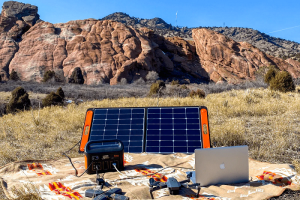Off-Grid Living: How to Balance Computer Power Consumption
In the evolving landscape of sustainable living, the confluence of technology and off-grid living presents a unique challenge. Many enthusiasts grapple with the question of “how much power does a computer use,” while concurrently exploring the benefits and drawbacks of off-grid living. Striking a balance between the energy demands of modern computing devices and the desire for self-sufficiency off the grid is crucial.

Understanding Computer Power Consumption
For those venturing into off-grid living, understanding the power consumption of their electronic devices is paramount. “How many watts does a computer use?” is a question that often arises, and the answer varies depending on the device. Laptops from major brands, ranging from MacBook to ASUS and HP, exhibit a broad spectrum of wattage consumption, spanning from 30W to 200W. Factoring in estimated working hours, one can gauge the daily power needs, with some gaming laptops surpassing the 1000W mark.
Pros and Cons of Off-Grid Living
Before delving into the intricacies of computer power consumption, it’s imperative to grasp the pros and cons of off-grid living. The allure of saving money, adopting a sustainable lifestyle, and ensuring protection from power outages are compelling reasons to embrace off-grid living. However, the journey comes with high initial costs and demands significant effort, particularly in establishing and maintaining essential resources like energy, water, and waste disposal.
Balancing Act: Computer Power and Off-Grid Living
As individuals contemplate the transition to off-grid living, a delicate balance emerges. On one hand, the desire to harness the advantages of sustainable living prompts a closer examination of energy-efficient computing solutions. On the other hand, the digital age demands increasingly powerful computers, leading to potential conflicts with the resource constraints inherent in off-grid living.
Strategies for Power-Efficient Computing Off the Grid
Navigating the conundrum of computer power consumption in an off-grid setting requires strategic approaches. Opting for energy-efficient laptops, embracing power-saving settings, and considering renewable energy sources for charging devices are pivotal steps. Awareness of the diverse wattage requirements of different laptops aids in making informed decisions aligned with the principles of off-grid living.
Conclusion
In the pursuit of a harmonious blend between technological advancements and sustainable living, the question of “how much power does a computer use” echoes prominently. By understanding the nuances of computer power consumption and weighing the pros and cons of off-grid living, individuals can carve a path that marries modern conveniences with eco-conscious choices. The delicate balance struck will not only define their energy footprint but also shape a lifestyle that champions self-sufficiency and environmental stewardship.
